THE REVIEW «AMERICAN ORNITHOLOGIE», 1901-1906



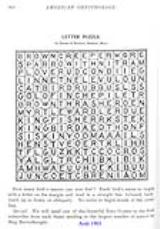
1901-1906
The magazine “American Ornithology for the Home and School” was published for the first time on January 1, 1901. The magazine, published monthly by Chester A. Reed and edited by his father, Charles K. Reed, was dedicated to the study of birds.
Each month, the magazine published articles about the environment and lifestyle of 4 or 5 bird species, along with full page drawings and scale pictures of eggs. A few stories and observation notes were added to the texts. The magazine was aimed for a large public: adults, teachers or students with an interest in bird study.
The first issue, in January 1901, included a descriptive chart of bird parts, as well as a chart of bird colors.
In the first issue, Chester was looking for collaborators to publish the magazine. He offered $3 for a 500-word article and $2 for pictures of birds in the wild. During the first year, he had few collaborators.
However, in the following year, many collaborators joined the publication team and provided a wide variety of information on new literature in ornithology, nature expedition stories, information on other ornithology groups and photography columns. There was a section for the young readers with wordplay, correspondence, charades, crossword puzzles and enigmas, all on the theme of birds. Consult the presentation’s slideshow.
In April 1902, in their magazine “The AUK,” the American Ornithologists Union featured an interview with Charles K. Reed, editor of “American Ornithology for the Home and School,” a year after the first publication of the magazine.
“Our magazine is entirely different from anything hitherto published, in that we propose to give the life history of four or five birds each month, the illustrations of the birds being of sufficient size to be of value, and the eggs of each bird illustrated “full size” – Charles K. Reed
The interview done by the prestigious organization recognized the important educative role played by the magazine “American Ornithology for the Home and School” in America.
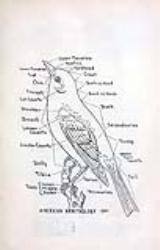

In the July 1901 issue, Chester mentioned that he needed more readers to reach an objective of 20,000 subscribers by January 1902. In January 1904, he proudly announced that the magazine “AO” had just acquired a machine that could produce 20,000 mailing labels per day, and that the number of subscribers was still growing.
Having a quality product was important, but the price of the subscription of the magazine most certainly contributed to the popularity of the magazine. It was always very affordable and stayed fairly the same over the years.
Here is a chart showing the subscription fees.
| Year of publication | Per issue | Yearly subscription including mailing fees | 12 magazines bound with hardcover |
|---|---|---|---|
| 1901/12 issues | $0.05 | $0.50 | $1.00 / 250 pages |
| 1902 / 12 issues | $0.10 | $1.00 | $1.00 / 386 pages |
| 1903 / 12 issues | $0.10 | $1.00 | $1.00 / 410 issues |
| 1904 / 12 issues | $0.10 | $1.00 | $1.00 / 426 pages |
| 1905 / 12 issues | $0.10 | $1.00 | $1.00 / 395 pages |
| 1906 / 7 issues | $0.10 | $1.00 |
In the first few months of the magazine’s publication, almost all of its ads featured products sold by Charles K. Reed. The publication costs were fairly low. In January 1901, a full page for advertising would cost $12.00, and an inch (a measure at the time) would cost $1.00.
The magazine’s popularity grew quickly over the year. The advertising rates show the growth. Six months after the publication of the first issue, a full page for advertising would cost $16.00 and a half page $8.00. The following month, in July 1901, a full page was $20.00 and a half page $10.00. It was uncommon to see such a quick rise in rates over a few months.
The reputation and the variety of advertisers was another way to judge the magazine’s popularity.
Some enterprises at that time, already known as “leaders” in their field, were advertisers which showed the importance of the ornithology community in America. Many of those are still active today.
Some ads which were published in the magazine “American Ornithology for the Home and School” were:
There was a wide variety of advertising in the magazine, for all tastes: taxidermists, enthusiasts, nature books, stamp collectors, shaving products for men, egg collectors (oologists), religious pictures, travel agencies, weapons, etc.
The magazine could publish between 40 and 45 ads. Below are two typical advertising pages published in May 1904:
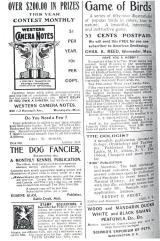
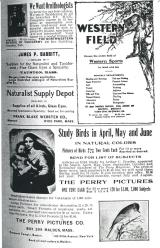
In 1903, the magazine changed its name and became “American Ornithology.” It was probably to get away from a magazine dedicated to schools, while their actual public was much different.
Chester started his professional career as a nature photographer in 1896. Photography had become his second nature. The magazine “AO” used a lot of bird pictures taken in the wild, which were the secret of its success. It had to keep a good amount of photos to meet the redaction needs.
The first photography contest by “AO” was thrown to help meet the material needed for the monthly publication of the magazine, to ensure high publication standards.
Here is the first ad published in “AO” in June 1902 to build a photo bank. One can notice that the publication is located among the other ads, which would lead us to think that it was a photo buying proposal, and not a contest.
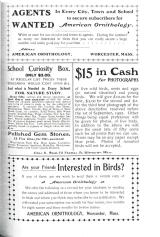

In addition, the word “contest” was not in the ad’s text. They emphasised the photos’ cash value. It clearly specified that $0.50 would be awarded to the author if their photo was used in the magazine.
In October 1902, Chester unveiled the photography contest’s winners. That first “contest” generated 287 bird pictures. For a large part of the participants, it was their first photography experience. That first experience helped Chester to better define the contest’s formula.
In 1903, the contest was announced in the magazine starting in April and divided into 3 categories.
A total of $50 was offered for the winners of each category.
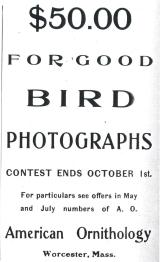
First category: Pictures of adult birds in the wild.
Second Category: Pictures of young birds.
Third Category: Pictures of nests or eggs.
The contest was open to amateurs and professionals.
In the November 1903 magazine, Chester announced that he had received a few thousands pictures for the three categories of the competition. A new photography activity was born.
In July 1904, a new association of photographers was created: “The National Association of Wild Animal Photographers.” The association was created to promote a new type of photography called “Camera Hunter.” The organization aimed to discourage the useless killing of birds and animals in America. One of the founding members was Mr. Leroy Melville Tifts, from the Department of Agriculture in Farmington, Maine. (The AUK, July 1904, p.410)
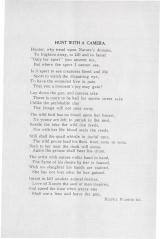 Here is an article published in “AO” in April 1904. Keep in mind that they were educating the people about animal conservation. Everything had to be done and written.
Here is an article published in “AO” in April 1904. Keep in mind that they were educating the people about animal conservation. Everything had to be done and written.
The magazine “AO” organized photography contests until 1905. It probably contributed to the creation of a new generation of “Camera Hunter” photographers. Photography was a popular topic in bird study articles published in “AO,” starting in 1901. It is probably why many advertisers used the magazine “American Ornithology” to promote photography products.
| April 1901
|
February 1903
|
February 1904
|
| April 1905
|
October 1905
|
February 1906
|
In 1911, Chester published the book “Camera Studies of Wild Birds in Their Homes.” Many pictures used in the book were taken by participants in the AO’s photography contests.
Chester received complete training on drawing techniques at the “Worcester Polytechnic Institute” (1). He excelled in color illustrations and was known at that time to reproduce the most natural, and to scale drawings. It was always his ultimate goal in bird illustration.
For Chester, the magazine “AO” was a way to share his discoveries and introduce people to ornithology. He started looking for ways to help others very early.
February 1902 was an important time in his career.
He published a color chart based on the similar characteristics of the birds to help identify them.
Here is the identification chart number 1, published in the magazine “American Ornithology for the Home and School” in February 1902.

The concept changed the ornithology hobby
Chester introduced the chart to his readers in the February 1902 AO editorial as follows:
«In this number we give IDENTIFICATION COLOR CHART – No 1.. We hope to give at least ten of these charts during the present year. The object of these is to furnish a ready means of identifying birds. You will notice that the most prominent color on all these birds is yellow; that the five on one side of the sheet have black throats and those on the other side have plain unmarked yellow throats. We shall follow the same plan with the subsequent charts. Birds having similar markings and color will be grouped together and the text will call attention to the distinguishing marks, and give the locality where each is found. It’s use: Suppose that a person in California sees an unknown small bird. He notes that the most striking color is yellow and that it has a black throat. Turning to the chart of yellow birds with black throats, he will find that only Townsend’s or Hermit Warbler are found in California. A glance will determine which he has seen. We sincerely hope that these charts will prove helpful to many, especially those just beginning the study and to teachers in their schools»

The chart was not only great for its color illustrations for bird identification, but also for the short descriptive texts that allowed readers to identify the bird, learn its Latin name, its dimensions, the description of the female if they were different and their dispersion.
Chester was already working on a new formula for a book that he published in November 1905.(2)
«Only a few days after the publication of Chester’s first identification chart, Mr. Frank M. Chapman went to the AO magazine’s office to discuss the publication of a new book. «Color Key to Birds of North America». (3) Mr. Chapman needed a talented illustrator who had an in-depth knowledge of birds to group them by similar species and for defining a structure to help identify them. Chester A. Reed met those qualifications.»(3)
Soon after, a new generation of books that would change ornithology forever was born.
Chester published 24 identification charts in “AO.” The last one was published on January 1, 1904.
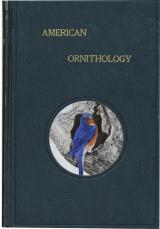
The magazine suggested original ideas on many aspects. One of them was that, at the end of each publication year, Charles and Chester published a hard cover book holding all articles published during the year. The books were popular for schools, youth ornithology clubs, and scout groups.
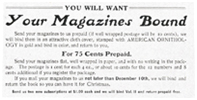
“AO” also offered to bind subscriber’s magazines. The readers only had to send their magazines, and AO would bind them for a fee of $0.75.
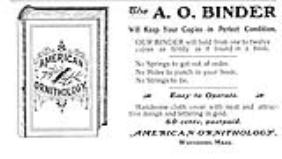
Charles and Chester invented a kind of binding that allowed the magazines to be bound like a book, without having to hole punch them. It was covered with fabric, had an attractive design, and had gold lettering. That type of binding had two patents: the first one on February 4, 1902 and the second one on August 5, 1902. People could buy the binding for $0.60, including postage.
You can consult Charles’ and Chester’s patents below:
Since the publication of the first color chart for bird identification produced in February 1902, things went fast for Chester. In November 1903, Mr. Frank Chapman published his book “Color Key to North American Birds,” to which Chester had contributed over 800 color pictures of birds in two years. In April 1904, Chester published his first book as a writer, “North American Birds Eggs.” In November 1905, he published his first “Bird Guide Part 2, Land Birds East of the Rockies.”(4)
At the beginning of January 1906, he started running out of free time.
Like every season, in January 1906, Chester invited readers to collaborate with the production of the magazine by providing texts on bird observation. In the April 1906 editorial, nothing showed that the end of the magazine’s publication was near, as he mentioned certain topics that would be covered in July.
However, the publication of his second book, “Bird Guide Part 1, Water Birds, Game Birds and Birds of Prey East of the Rockies” in April 1906 changed his plans.
He first tried maintaining the AO magazine’s publication in June 1906, when he announced that it would then be published every two months. Chester was reassuring to his readers and asked them to provide more short articles for the magazine. His attempt did not survive for the next publication of the magazine.
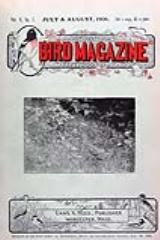
The last issue of “American Ornithology” (July – August, vol. 6, no. 7) was published in August 1906. The end of the magazine was not mentioned. However, it hinted to what was probably the end’s triggering factor.
In the last issue’s editorial, Chester mentioned that 27,000 “Bird Guide” books had been sold. His books had only been on the shelves for a few months. The success gained from the books’ publication made it impossible for him to maintain the high quality publication of the magazine. One could already feel his lack of time by the cover of the last issue. In addition, Chester had started the production of his next book which would be published a few months later, in January 1907.
Between 1906 and 1912, Chester published 23 books on ornithology, all edited by his father. (4) (4)
You can consult the slideshow of the presentation.
Comments :